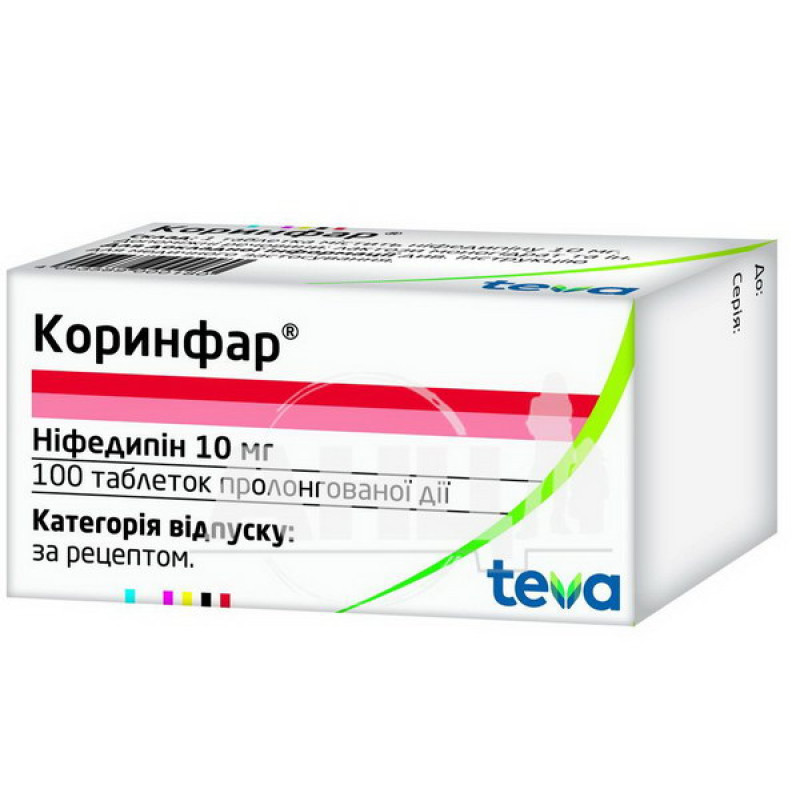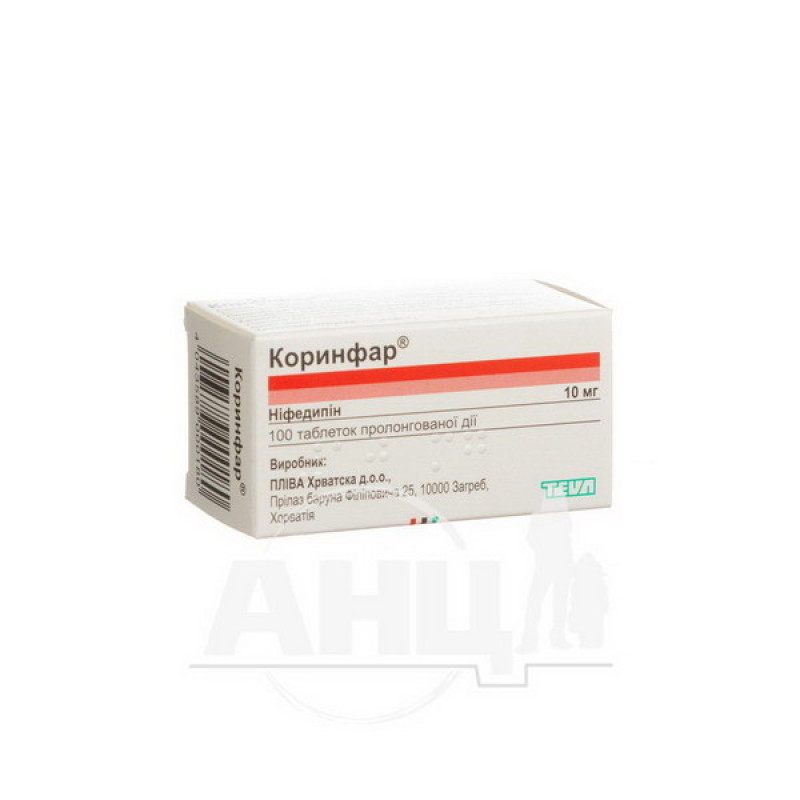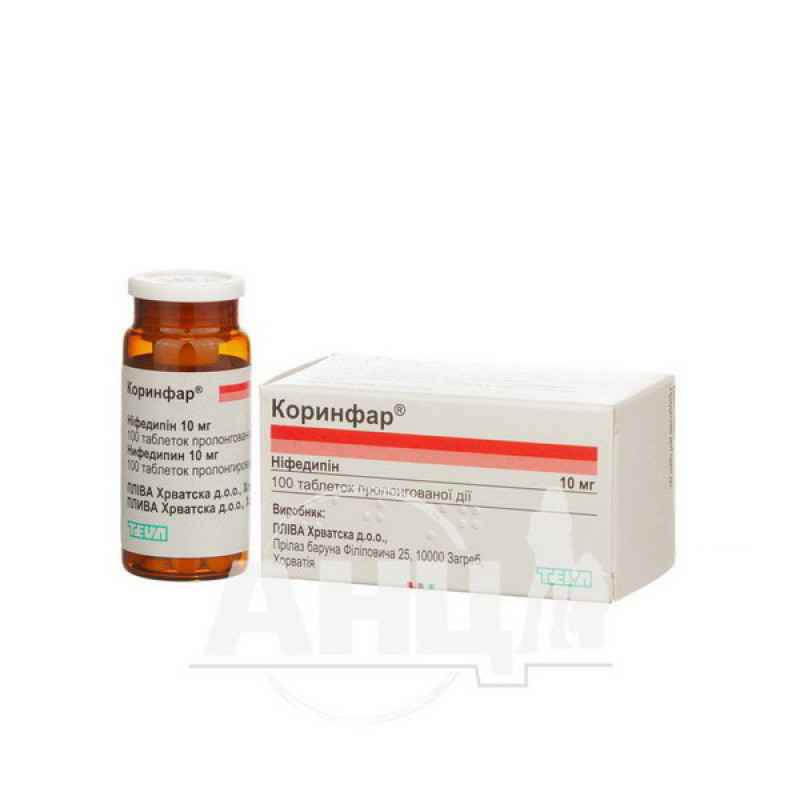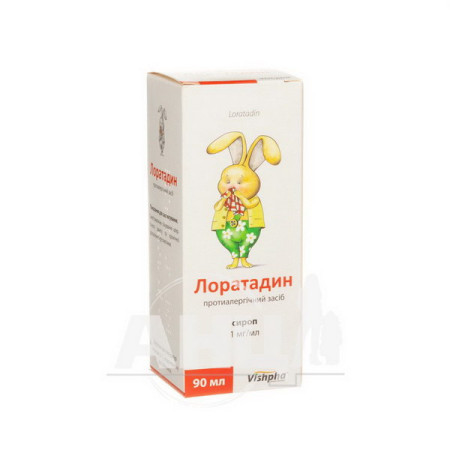Corinfar prolonged-release tablets 10 mg bottle No. 100

Instructions for Corinfar prolonged-release tablets 10 mg bottle No. 100
Composition
active ingredient: nifedipine;
1 tablet contains 10 mg of nifedipine;
excipients: lactose monohydrate, potato starch, microcrystalline cellulose, povidone, magnesium stearate, hypromellose, macrogol 6000, macrogol 35000, quinoline yellow (E 104), titanium dioxide (E 171), talc.
Dosage form
Extended-release tablets.
Main physicochemical properties: yellow, biconvex, round, film-coated tablets with beveled, undamaged edges and uniform in appearance.
Pharmacotherapeutic group
Selective calcium antagonists with a predominant effect on blood vessels. ATX code C08C A05.
Pharmacological properties
Pharmacodynamics.
Nifedipine is a calcium antagonist that inhibits the influx of calcium into myocardial cells, coronary artery smooth muscle, and peripheral capillaries. Nifedipine dilates the coronary arteries and reduces coronary artery muscle tone, thereby increasing oxygen delivery. At the same time, it reduces total peripheral vascular resistance (afterload), thereby relieving the heart. By weakening the work of the heart, it reduces oxygen demand. Normalization of blood pressure occurs due to the expansion of systemic arteries and arterioles, as well as due to the reduction of total peripheral vascular resistance.
Especially at the beginning of treatment, heart rate and cardiac output may increase due to activation of the baroreceptor reflex. During long-term treatment with nifedipine, heart rate and cardiac output return to pre-therapeutic values.
Pharmacokinetics.
Absorption
After oral administration, nifedipine is rapidly and almost completely absorbed. The absorption of nifedipine is 50-60%.
The release of nifedipine from prolonged-release tablets occurs more slowly and reaches maximum serum concentrations 2-4 hours after administration; its effect lasts 10-12 hours.
Distribution
Nifedipine is 94-99% bound to plasma proteins, mainly albumin. Animal studies have shown that released nifedipine is distributed to all organs and tissues. The concentration in cardiac muscle was higher than in skeletal muscle. Neither nifedipine nor its metabolites accumulate in tissues.
Metabolism
Nifedipine is almost completely metabolized in the liver by cytochrome
P450 isoenzyme CYP3A4. Metabolites are pharmacologically inactive. In patients with impaired liver function, metabolism is somewhat slowed.
Breeding
80% of the metabolites are excreted in the urine, the rest in the feces. Only a small amount of unchanged nifedipine is excreted in the urine. The half-life after oral administration of the prolonged-release tablet is 8-10 hours; it may be slightly prolonged in patients with renal insufficiency.
Indication
Treatment of arterial hypertension.
Treatment of angina pectoris (mainly vasospastic and chronic stable angina pectoris).
Contraindication
– Hypersensitivity to nifedipine or to any other component of the drug;
– cardiogenic shock;
– concomitant use of rifampicin (due to the inability to achieve effective levels of nifedipine in blood plasma due to enzyme induction);
– unstable angina;
– acute myocardial infarction (within the first 4 weeks);
– high-grade aortic stenosis;
− ileostomy or colostomy.
Interaction with other medicinal products and other types of interactions
Drugs that affect the effectiveness of nifedipine.
Nifedipine is metabolized by the cytochrome P450 3A4 system, which is located in the intestinal mucosa and liver. Therefore, drugs that inhibit or induce this enzyme system may alter the "first pass" (after oral administration) or clearance of nifedipine.
When using nifedipine together with the following drugs, the degree and duration of interaction should be taken into account.
Rifampicin
Rifampicin significantly induces the cytochrome P450 3A4 system. When used simultaneously with rifampicin, the bioavailability of nifedipine is significantly reduced and thus its efficacy is weakened. In view of this, the use of the combination of nifedipine with rifampicin is contraindicated.
When concomitantly using the following weak or moderate inhibitors of the cytochrome P450 3A4 system, blood pressure should be monitored and, if necessary, a reduction in the nifedipine dose should be considered.
Macrolide antibiotics (e.g., erythromycin)
No interaction studies have been conducted between nifedipine and macrolide antibiotics. Certain macrolide antibiotics inhibit the cytochrome P450 3A4-mediated metabolism of other drugs. Therefore, an increase in nifedipine plasma concentrations cannot be excluded when both drugs are administered simultaneously.
Azithromycin, which is structurally similar to members of the macrolide class of antibiotics, does not inhibit CYP3A4.
No clinical study has been conducted to investigate the potential for interactions between nifedipine and certain anti-HIV protease inhibitors. Drugs in this class are known to inhibit the cytochrome P450 3A4 system. In addition, drugs in this class inhibit the cytochrome P450 3A4-mediated metabolism of nifedipine in vitro. When used concomitantly with nifedipine, a significant increase in nifedipine plasma concentrations cannot be excluded due to a decrease in first-pass metabolism and a decrease in the rate of elimination.
Azole antifungals (e.g., ketoconazole)
No formal clinical study has been conducted to investigate the potential for interactions between nifedipine and certain azole antifungals. Drugs of this class are known to inhibit the cytochrome P450 3A4 system. When administered orally with nifedipine, a significant increase in the systemic bioavailability of nifedipine due to a decrease in first-pass metabolism cannot be excluded.
Fluoxetine
No clinical study has been conducted to investigate the potential for interaction between nifedipine and fluoxetine. Fluoxetine is known to inhibit the cytochrome P450 3A4-mediated metabolism of nifedipine in vitro. An increase in nifedipine plasma concentrations cannot be excluded when both drugs are administered concomitantly.
Nefazodone
No clinical study has been conducted to investigate the potential for interaction between nifedipine and nefazodone. Nefazodone is known to inhibit the cytochrome P450 3A4-mediated metabolism of other drugs in vitro. An increase in nifedipine plasma concentrations cannot be excluded when both drugs are administered concomitantly.
Quinupristin/dalfopristin
Concomitant use of quinupristin/dalfopristin and nifedipine may lead to an increase in nifedipine plasma concentrations.
Valproic acid
No formal clinical study has been conducted to investigate the potential for interaction between nifedipine and valproic acid. Valproic acid is known to increase plasma concentrations of the structurally related calcium channel blocker nimodipine through enzyme inhibition, and therefore an increase in nifedipine plasma concentrations and efficacy cannot be excluded.
Cimetidine, ranitidine
Due to inhibition of cytochrome P450 3A4, cimetidine/ranitidine increases plasma concentrations of nifedipine and may enhance the antihypertensive effect. Cimetidine acts as an inhibitor of the cytochrome isoenzyme CYP3A4. Nifedipine should be administered with caution to patients already taking cimetidine, and its dosage should be increased more gradually.
Additional research
Cisapride
Concomitant use of cisapride and nifedipine may lead to an increase in the concentration of nifedipine in the blood plasma.
Antiepileptic drugs that induce the cytochrome P450 3A4 system, such as phenytoin, carbamazepine, and phenobarbital
Phenytoin induces the cytochrome P450 3A4 system. When used simultaneously with phenytoin, the bioavailability of nifedipine is reduced and its efficacy is weakened. When both drugs are used simultaneously, the clinical response to nifedipine therapy should be monitored and, if necessary, an increase in the nifedipine dose should be considered. In the event of an increase in the nifedipine dose during the simultaneous use of both drugs, a decrease in the nifedipine dose should be considered when phenytoin is discontinued.
No formal clinical studies have been conducted to investigate the possibility of a potential interaction between nifedipine and carbamazepine or phenobarbital. Both drugs are known to reduce plasma concentrations of the structurally similar calcium channel blocker nifedipine due to enzyme induction. Therefore, a decrease in nifedipine plasma concentrations and reduced efficacy cannot be excluded.
Diltiazem reduces the breakdown of nifedipine, which may require a dose reduction.
Effect of nifedipine on other drugs
Antihypertensive drugs
Nifedipine may increase the hypertensive effect of concomitantly used antihypertensive drugs, such as:
− diuretics;
− β-blockers;
− ACE inhibitors;
− AT-1 receptor antagonists;
− other calcium antagonists;
− α-adrenergic blockers;
− PDE5 inhibitors;
− α-methyldopa;
− magnesium sulfate.
When using glyceryl trinitrate and prolonged-release isosorbide, the synergistic effect of nifedipine should be taken into account.
Concomitant administration of nifedipine and tricyclic antidepressants may lead to increased serum concentrations of these drugs and enhanced antihypertensive effects of nifedipine.
Fentanyl may cause hypotension in patients treated with nifedipine. Nifedipine should be withheld for at least 36 hours prior to elective surgery using fentanyl-based anesthesia.
Nifedipine may lead to magnesium sulfate toxicity, which causes neuromuscular blockade. The simultaneous use of nifedipine and magnesium sulfate is not recommended because it is dangerous and can threaten the patient's life.
Nifedipine may alter bronchial reactivity to methacholine. Nifedipine should be discontinued (if possible) before a nonspecific methacholine challenge test.
When nifedipine is used concomitantly with β-blockers, careful monitoring of the patient's condition is required, as isolated cases of exacerbation of heart failure are known.
Digoxin, theophylline
When nifedipine is taken simultaneously with theophylline or digoxin, the concentration of theophylline or digoxin in the blood serum may increase. It is recommended to monitor the concentration of theophylline or digoxin in the blood serum and adjust the dose if necessary.
Quinidine
When nifedipine and quinidine are used simultaneously, in some cases a decrease in quinidine levels was observed, and when nifedipine was discontinued, a sharp increase in quinidine plasma concentrations was observed. Therefore, when nifedipine is used simultaneously or discontinued, it is recommended to monitor quinidine plasma concentrations and, if necessary, adjust the quinidine dose. An increase in nifedipine plasma concentrations has been reported with the simultaneous use of both drugs, but no changes in nifedipine pharmacokinetics were observed.
Therefore, blood pressure should be closely monitored when quinidine is included in the nifedipine regimen. If necessary, the nifedipine dose should be reduced.
Tacrolimus
Tacrolimus is known to be metabolised by the cytochrome P450 3A4 system. Published data suggest that in some cases the dose of tacrolimus may need to be reduced when co-administered with nifedipine. Plasma tacrolimus concentrations should be monitored when both drugs are co-administered and a reduction in the tacrolimus dose should be considered if necessary.
With simultaneous use of vincristine - there is a weakening of vincristine excretion, a decrease in dose; with cephalosporins - an increase in cephalosporin levels in blood plasma.
Other types of interactions
Grapefruit juice
Grapefruit juice inhibits the cytochrome P450 3A4 system. The use of grapefruit juice while taking nifedipine leads to an increase in the concentration of the drug in the blood plasma and an increase in the duration of action of nifedipine due to a decrease in first-pass metabolism or a decrease in clearance. As a result, the antihypertensive effect of the drug may be enhanced. After regular consumption of grapefruit juice, this effect may persist for at least 3 days after the last intake of the juice.
Therefore, grapefruit/grapefruit juice should be avoided during nifedipine therapy.
The use of nifedipine may lead to falsely elevated results in spectrophotometric determination of vanillylmandelic acid concentration in urine (however, this effect is not observed when using the high-performance liquid chromatography method).
Application features
The drug should be used with caution in cases of severe arterial hypotension (systolic blood pressure below 90 mm Hg) and severe heart failure.
Patients with impaired liver function require careful monitoring, and in severe cases, a dose reduction.
Nifedipine is metabolized via the cytochrome P450 3A4 system; therefore, drugs that inhibit or induce this enzyme system may alter the "first pass" or clearance of nifedipine.
Drugs that are weak or moderate inhibitors of the cytochrome P450 3A4 system and may lead to an increase in nifedipine plasma concentrations include, for example:
− macrolide antibiotics (e.g. erythromycin),
− anti-HIV protease inhibitors (e.g. ritonavir),
− azole antifungals (e.g. ketoconazole),
- antidepressants (nefazodone and fluoxetine),
− quinupristin/dalfopristin,
− valproic acid,
− cimetidine.
When nifedipine is used concomitantly with these drugs, blood pressure should be monitored and, if necessary, a reduction in the nifedipine dose should be considered.
As with other non-deformable materials, caution should be exercised when using the drug in patients with severe gastrointestinal narrowing due to the possibility of obstructive symptoms. Very rarely, bezoars may occur, which may require surgical intervention.
In isolated cases, obstructive symptoms have been described in the absence of a history of gastrointestinal disorders.
The drug should not be used in patients with an ileostomy (ileostomy after proctocolectomy).
The use of the drug may lead to false-positive results in X-ray examinations using barium contrast media (for example, filling defects are interpreted as a polyp).
The drug should not be used if there is a possible connection between previous use of nifedipine and ischemic pain. In patients with angina pectoris, attacks may occur more frequently, and their duration and intensity may increase, especially at the beginning of treatment.
Some in vitro experiments have shown an association between the use of calcium antagonists, particularly nifedipine, and reversible biochemical changes in spermatozoa that impair their ability to fertilize. In cases where in vitro fertilization attempts are unsuccessful, in the absence of other explanations, calcium antagonists, particularly nifedipine, may be considered as a possible cause of this phenomenon.
Patients with rare hereditary problems of galactose intolerance, the Lapp lactase deficiency or glucose-galactose malabsorption should not take this medicine.
Grapefruit juice inhibits the metabolism of nifedipine, which leads to an increase in its concentration in blood plasma.
Use during pregnancy or breastfeeding
The use of nifedipine is contraindicated during pregnancy (up to 20 weeks).
The use of nifedipine during pregnancy after 20 weeks requires a careful assessment of the risk/benefit ratio, and the question of therapy with the drug should be considered only in cases where all other treatment tactics are either not indicated or have proven ineffective. There are no results of adequate and well-controlled studies of the use of the drug in pregnant women.
Animal studies have shown embryotoxicity, fetotoxicity, and teratogenicity of the drug.
When using the drug simultaneously with intravenous administration of magnesium sulfate, careful monitoring of blood pressure is necessary due to the possibility of a significant decrease in blood pressure, which may harm the mother and fetus.
Nifedipine passes into breast milk, so breastfeeding should be discontinued if the drug must be used during lactation.
Ability to influence reaction speed when driving vehicles or other mechanisms
Therapy with this drug requires constant medical supervision. Due to the difference in individual reactions to the drug, the ability to drive vehicles, operate machinery, and perform actions that require a body position without support is impaired. These precautions mainly apply to the initial period of therapy, the period of increasing the dose of the drug, and when switching to another drug.
Method of administration and doses
The dosage regimen should be determined individually, taking into account the severity of the disease and the patient's response to the treatment used.
Depending on the individual clinical picture, the recommended dose should be increased gradually.
The usual initial and maintenance dose of the drug in all cases is 1 tablet 2 times a day. If necessary, the dose can be increased to 2 tablets 2 times a day. In patients with Prinzmetal's angina (vasospastic), the daily dose can be increased to a maximum dose of 60 mg.
Patients with hepatic insufficiency require constant monitoring and may require a dose reduction.
The drug should be taken without chewing, after meals, with sufficient liquid (except grapefruit juice), preferably in the morning and evening at the same time.
Taking food with the tablet slows down, but does not reduce, absorption.
Therapy with the drug should be discontinued gradually, especially in cases of taking the drug in high doses.
Prolonged-release tablets should not be divided, as in this case the protection against light provided by the protective coating is no longer provided.
Children
The safety and efficacy of nifedipine in children have not been adequately studied; therefore, nifedipine should not be prescribed to children.
Overdose
Symptoms of acute intoxication: impaired consciousness, up to the development of coma, hypotension, tachycardia/bradycardia, hyperglycemia, metabolic acidosis, hypoxia, cardiogenic shock accompanied by pulmonary edema.
Treatment. The most important therapeutic measures are to remove the drug from the body and restore stable functioning of the cardiovascular system.
After oral administration, it is recommended to completely empty the stomach, if necessary in combination with small bowel lavage. In cases of intoxication caused by prolonged-release preparations, efforts should be made to eliminate the drug from the body as completely as possible, including from the small intestine, to prevent absorption of the active substance.
When using laxatives, it should be borne in mind that calcium antagonists lead to a decrease in intestinal muscle tone up to intestinal atony. Since nifedipine is characterized by a high degree of binding to blood plasma proteins and a relatively small volume of distribution, hemodialysis is ineffective, but plasmaphoresis is recommended.
Arterial hypotension resulting from cardiogenic shock and vasodilation can be treated with calcium preparations (10-20 ml of a 10% solution of calcium chloride or gluconate is administered intravenously slowly, then repeated if necessary). As a result, serum calcium levels may reach the upper limit of normal or be slightly elevated. If calcium administration is not effective enough, it is advisable to use dopamine, dobutamine, adrenaline or noradrenaline. The doses of these drugs should be determined taking into account the achieved therapeutic effect. Additional fluid administration should be approached very carefully, since this increases the risk of cardiac overload.
Adverse reactions
From the side of the hematopoietic and lymphatic systems: changes in blood count, anemia, leukopenia, thrombocytopenia and thrombotic microangiopathy, agranulocytosis, thrombocytopenic purpura.
Immune system disorders: allergic reactions, allergic edema (including laryngeal edema), pruritus, urticaria, rash, anaphylactic/anaphylactoid reaction, angioedema, facial edema.
Metabolic: hyperglycemia (especially in patients with diabetes).
Nervous system: headache, dizziness, migraine, tremor, paresthesia, dysesthesia, hypoesthesia, drowsiness, vertigo.
On the part of the psyche: anxiety reactions, sleep disorders, mood changes, nervousness.
On the part of the organs of vision: slight, temporary change in visual perception, visual impairment, eye pain, excessive tearing.
Cardiovascular: hot flashes, palpitations, tachycardia, angina pectoris, edema, vasodilation, loss of consciousness, hypotension, symptomatic hypotension, orthostatic hypotension, myocardial infarction, chest pain, erythromegaly, especially at the beginning of treatment. In patients with malignant hypertension and hypovolemia who are on hemodialysis, a significant decrease in blood pressure due to vasodilation may occur.
On the part of the respiratory system: nosebleeds, nasal congestion, dyspnea, cough, spasticity of the bronchial muscles up to life-threatening shortness of breath, which disappears after discontinuation of treatment.
On the part of the digestive tract: constipation, digestive tract dysfunction such as dyspepsia, diarrhea, abdominal pain, flatulence, nausea, vomiting, dry mouth, gingival hyperplasia, gastroesophageal sphincter insufficiency, feeling of fullness of the stomach, belching, lack of appetite, gastrointestinal pain, bezoar, dysphagia, intestinal ulcer, intestinal obstruction.
On the part of the hepatobiliary system: transient increase in transaminase activity, jaundice, cholestasis.
Skin and subcutaneous tissue disorders: erythema, Mitchell's disease, hypersensitivity skin reactions such as itching, exanthema, swelling of the skin and mucous membranes, increased sweating, urticaria, photodermatitis, purpura, toxic dermal necrolysis, exfoliative dermatitis, photosensitivity reaction.
Musculoskeletal system: myalgia, arthralgia, muscle cramps, joint swelling.
On the part of the kidneys and urinary tract: temporary decrease in kidney function in cases of renal failure; increased frequency of urination, increased daily urine output, polyuria, dysuria, nocturia.
On the part of the reproductive system and mammary glands: gynecomastia (the process is reversible, the symptoms disappear after stopping nifedipine), erectile dysfunction.
General disorders: increased fatigue, feeling of malaise, fever, nonspecific pain.
Expiration date
3 years.
Storage conditions
Store at a temperature not exceeding 30 °C in the original packaging in order to protect from light. Keep out of the reach of children.
Packaging
10 tablets in a blister, 3 blisters in a box; 50 or 100 tablets in a bottle, 1 bottle in a box.
Vacation category
According to the recipe.
Producer
PLIVA Hrvatska d.o.o.
Location of the manufacturer and address of its place of business
Prilaz baruna Filipovića 25, 10 000 Zagreb, Croatia.
Applicant
Teva Pharmaceutical Industries Ltd.
Location of the applicant and/or applicant's representative
5 Bazelya St., P.O. Box 3190, 49131 Petah Tikva, Israel
The applicant's representative in Ukraine, Azerbaijan, Georgia, Armenia and Moldova is Teva Ukraine LLC, tel. +38 044 240 17 67, www.teva.ua.
There are no reviews for this product.
There are no reviews for this product, be the first to leave your review.
No questions about this product, be the first and ask your question.










